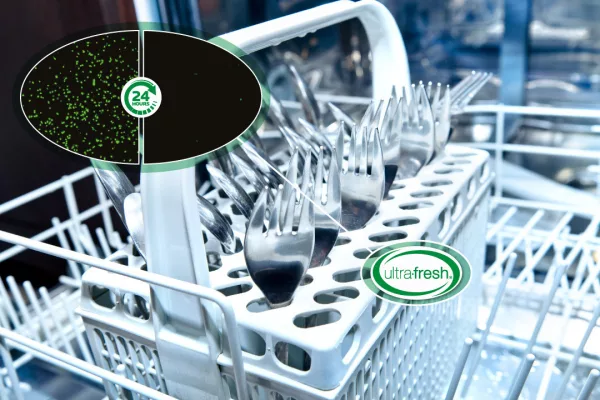Why mold grows in dishwasher plastics
You're not alone if you've spotted black mold or stubborn smells in your dishwasher. Mold in dishwasher plastics is a common frustration. High temperatures, moisture, and residual food particles create an ideal breeding ground for mold and mildew on plastic surfaces.
Over time, even regular dishwashing cycles may not eliminate microbial buildup on its own, especially in hard-to-clean corners and textured plastics. This makes the cleanliness and usability of dishwashers a potential concern.
Signs of mold in plastic dishwasher items
How can you tell if you're dealing with mold or mildew on plastic? Here are the telltale signs:
- Pink staining or slime
Pink mold on plastic is typically a strain of bacteria that favors damp environments. It's often found in the crevices of plastic dish racks and sealant in built-in dishwashers. - Visible mold or mildew around the edges
Black or green specks near seams can indicate mold or mildew. These spots may keep reappearing even after scrubbing. - Lingering odors despite cleaning
If your dishwasher smells musty even after a cleaning cycle, microbial buildup on plastic parts could be the culprit.
How antimicrobial protection helps consumer plastics
Ultra-fresh antimicrobial protection works by integrating antimicrobial additives into the plastic during manufacturing. These additives create a surface that resists microbial growth, helping keep items fresher and cleaner between washes. While antimicrobial surface protection doesn't replace regular cleaning, it helps prevent the buildup of stains, odors, and visible mold that can lead to premature degradation and replacements.

Why it matters for everyday consumer plastics
While dishwasher cutlery baskets are a prime example, many household items benefit from built-in antimicrobial technology:
Plastic dish racks are exposed to daily moisture and drying cycles.
Food storage containers, especially those that are difficult to dry fully
Shower caddies and soap trays with constant water and residue contact
These products are often damp and challenging to clean thoroughly, making them vulnerable to mold on plastic. Antimicrobial protection provides a layer of defense, transforming everyday essentials into mold-resistant plastic products that stay fresher for longer.
FAQs about mold and antimicrobial plastics
Q. Can mold grow on dishwasher-safe plastic?
A. Yes. Dishwasher-safe plastic doesn’t mean mold-proof. Repeated exposure to heat, moisture, and food debris can lead to microbial growth.
> Full article: Can mold grow on plastic?
Q. How does mold or mildew visibly compare?
A. Mildew is usually light-colored and powdery, while mold is darker and more entrenched. Both can appear on dishwasher plastics.
> Mold vs. mildew – how to tell the difference
Q. Does antimicrobial mean it’s germ-free?
A. No. Antimicrobial protection inhibits microbial growth on the surface, but it doesn't sterilize or replace cleaning.
Keeping dishwasher plastics cleaner for longer with Ultra-Fresh
Mold and mildew on plastic—particularly in dishwasher cutlery baskets—are more than cosmetic annoyances. They're signs of microbial buildup that can affect cleanliness, odor, and product lifespan. Built-in antimicrobial protection offers an effective way to combat this issue, helping consumer antimicrobial plastics stay cleaner between uses and extending the life of household items.
